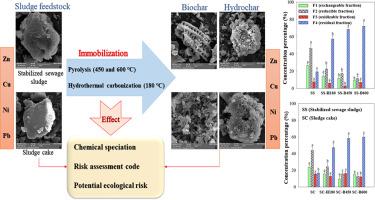Ecological Engineering ( IF 3.8 ) Pub Date : 2021-02-05 , DOI: 10.1016/j.ecoleng.2021.106173 Mozhdeh Alipour , Hossein Asadi , Chengrong Chen , Mehran Rezaei Rashti

|
The rapid increase in municipal sewage sludge production due to quick urbanization and economic development raised significant socio-economic and environmental issues in recent years. Although the increase in heavy metals' (HMs) immobilization through pyrolysis and hydrothermal carbonization (HTC) of municipal sewage sludge are reported in previous investigations, but there is still limited information available regarding the potential environmental risks associated with these processes. This study investigated the chemical speciation, bioavailability and eco-toxicity of HMs (Zn, Cu, Ni and Pb) in biochars (pyrolysis temperatures of 450 °C and 600 °C) and hydrochars (HTC temperature of 180 °C) produced from two sludge feedstocks (sludge cake and stabilized sewage sludge). The HTC generally resulted in higher char yield compared to pyrolysis process. The raw sewage samples showed a flat morphological surface texture, while HTC process increased the porosity and surface area of produced hydrochars. The pyrolysis process also increased the porous structures and surface morphology of biochars, with higher porosity in biochars produced at 600 °C. The pH value of hydrochars was significantly (P < 0.05) lower than the sludge feedstock, while pyrolysis process significantly (P < 0.05) increased the pH value of produced biochars. The H/C and O/C ratios of char products were gradually decreased by increasing production temperature, illustrating the formation of higher aromaticity and stronger carbonization. The concentration order of HMs in sludge feedstock was Zn > Cu > Pb > Ni, and with thermochemical processes the concentration of HMs increased in biochar and hydrochar products. The enrichment of HMs in all biochars was significantly (P < 0.05) higher than hydrochars. The concentration of HMs significantly (P < 0.05) reduced in bioavailable fraction and increased in stable fraction during pyrolysis and HTC processes. Consequently, the potential environmental risk and eco-toxicity of HMs significantly (P < 0.05) decreased in hydrochars and biochars with low or no environmental risk of direct land application.
中文翻译:

在热解和水热碳化过程中,城市污水污泥产生的焦炭中重金属的生物利用度和生态毒性降低
近年来,由于快速的城市化和经济发展,城市污水污泥生产迅速增加,引发了重大的社会经济和环境问题。尽管在先前的调查中报告了通过热解和水热碳化(HTC)固定城市污水污泥的重金属(HMs)固定化的增加,但是关于与这些过程相关的潜在环境风险的信息仍然有限。这项研究调查了在两种生物炭(热解温度为450°C和600°C)和水炭(HTC温度为180°C)中生成的重金属(锌,铜,镍和铅)的化学形态,生物利用度和生态毒性。污泥原料(污泥饼和稳定的污水污泥)。与热解过程相比,HTC通常导致更高的焦炭收率。原始污水样品显示出平坦的表面形貌,而HTC工艺则增加了所产生的碳氢化合物的孔隙率和表面积。热解过程还增加了生物炭的多孔结构和表面形态,在600°C下产生的生物炭具有更高的孔隙率。炭的pH值显着低于污泥原料(P <0.05),而热解工艺显着(P <0.05)提高了所生产生物炭的pH值。随着生产温度的升高,焦炭产品的H / C和O / C比逐渐降低,说明形成了更高的芳香性和更强的碳化性。污泥原料中HMs的浓度顺序为Zn> Cu> Pb> Ni,随着热化学过程的发展,生物炭和水焦产品中HMs的浓度增加。HMs在所有生物炭中的富集度均显着高于水炭(P <0.05)。在热解和HTC过程中,HMs的浓度可生物利用分数显着降低(P <0.05),而稳定分数则增加。因此,在具有直接土地施用的低环境风险或无环境风险的水生炭和生物炭中,重金属的潜在环境风险和生态毒性显着降低(P <0.05)。05)在热解和HTC过程中,生物利用度降低,稳定度提高。因此,在具有直接土地施用的低环境风险或无环境风险的水生炭和生物炭中,重金属的潜在环境风险和生态毒性显着降低(P <0.05)。05)在热解和HTC过程中,生物利用度降低,稳定度提高。因此,在具有直接土地施用的低环境风险或无环境风险的水生炭和生物炭中,重金属的潜在环境风险和生态毒性显着降低(P <0.05)。



























 京公网安备 11010802027423号
京公网安备 11010802027423号